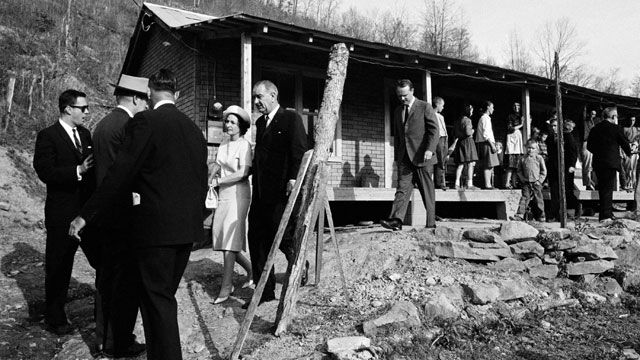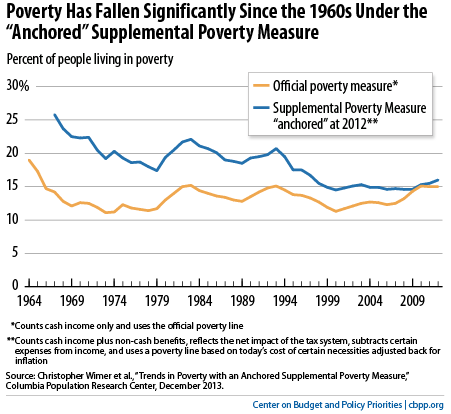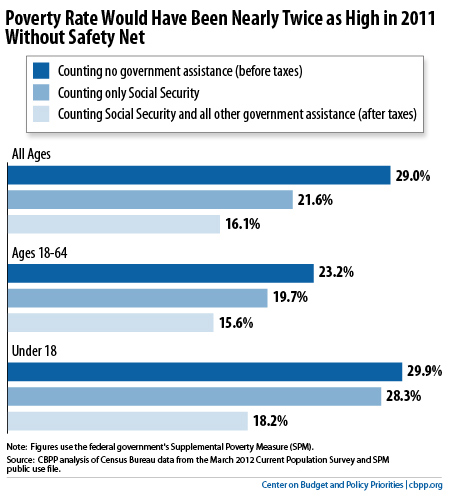
With the 50th anniversary of the War on Poverty upon us, brace yourself for efforts by conservatives to discredit and dismantle programs that are keeping poverty from reaching epidemic proportions.
The crux of the conservative argument is that the official poverty rate of 15 percent isn’t much better than it was 50 years ago when President Lyndon Johnson launched his ambitious campaign.
But to reach that conclusion one needs to use a poverty measurement that doesn’t take into account the effects of some of our nation’s best tools to fight poverty — such as nutrition assistance, the Earned Income Tax Credit, or housing assistance. It would be like saying pollution is about the same as it was prior to clean air and clean water legislation, provided that you don’t count the effects of emissions controls, scrubbers and other pollution-reducing technologies invented since then.
If we use a more comprehensive measure of poverty — one that includes the benefits of the range of antipoverty programs — we get a much more accurate picture of how the War on Poverty is faring. A recent Columbia University study using such a measure reveals that the safety net reduced the number of Americans living in poverty from 26 percent in 1967 to 16 percent in 2012.
Arloc Sherman, senior researcher at the Center for Budget and Policy Priorities (CBPP), has shown that poverty would have been nearly twice as high — 29 percent — in 2011 without the safety net.
The only question we should be asking at this moment is a simple one: if our current anti-poverty tools are cutting the poverty rate nearly in half, what do we need to do to make new significant reductions?
The most obvious answer is to raise the minimum wage to $10.10 an hour as proposed by Senator Tom Harkin (D-IA) and Representative George Miller (D-CA) and endorsed by President Obama. (The bill would also raise the tipped minimum wage that is currently $2.15 an hour.) Historically, in the 1960s and ’70s, the minimum wage was sufficient to raise a family of three out of poverty. But today, a full-time worker earning the $7.25 federal minimum wage has an income of approximately $15,000, well below the poverty threshold of $19,530 for a family of three. We need to get back on track so that millions of Americans can lift their families out of poverty through their own hard work.
We should also make quality childcare affordable to every American — just as it is available to parents in virtually every other industrialized nation. Currently, too many parents are forced to choose between staying at home or going to work and placing their children in a tenuous child care situation. In 2010, poverty rates for families headed by a single mother dropped from 40.7 percent to 14 percent when the mother could secure full-time, year-round employment—and affordable childcare is key to that equation. But the average annual fee for full-time child care currently ranges from $3,900 to $15,000 and families in poverty spend an average of 40 percent of their income on childcare. The bipartisan Strong Start for America’s Children Act would significantly expand access to high-quality preschool as well as infant and toddler care, as would President Obama’s early learning proposal.
We also need to have a much more honest conversation about how welfare reform has failed and succeeded and make changes where necessary. The expansions of the Earned Income Tax Credit (EITC) and Child Tax Credit have lifted millions of families above the poverty line — 9.4 million people in 2011, for example. But low-income workers without children receive a much smaller version of the credit. As a result, they are the only group of people the federal government taxes deeper into poverty. Childless workers under 25 are also ineligible. By expanding eligibility to these workers, millions of more Americans will be able to work their way out of poverty.
Further, for a TANF program that purportedly is designed to promote self-sufficiency, it is ludicrous that many states aren’t allowing individuals to pursue a course of education that leads to a family-supporting wage. I recently met two women from Boston who were told they needed to drop out of college in order to continue receiving TANF and childcare assistance — just months before they would have obtained their degrees. Another woman from Philadelphia had just gotten a job as a home health care aide earning $9 an hour. She said she had two weeks until she would lose her childcare assistance and would actually be worse off economically for taking the job. This is known as “the cliff effect,” and it makes it far more difficult for people to escape poverty.
For years advocates have bemoaned the “lack of political will” to take steps like these in the fight against poverty. But the real question for those of us who seek change needs to be, “What are we doing to create the political will?”
Just as the labor movement lay the groundwork for the New Deal, and the civil rights movement for the Civil Rights Act, the reforms now needed to combat poverty will only arise through a movement that is sustained, visible and steadfast in its refusal to accept the status quo. It must capture the imagination and the media’s attention and issue specific demands that have popular appeal.
That’s how we will make the next significant strides in the fight against poverty.




